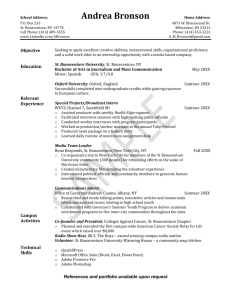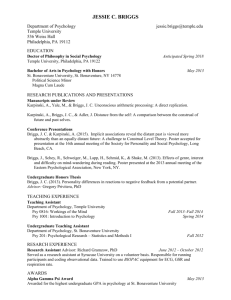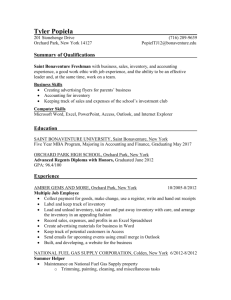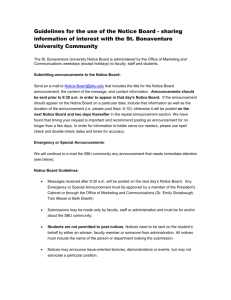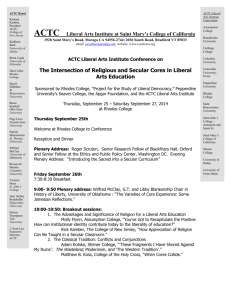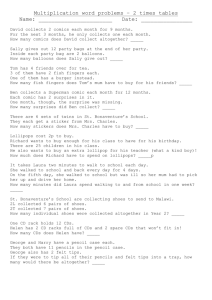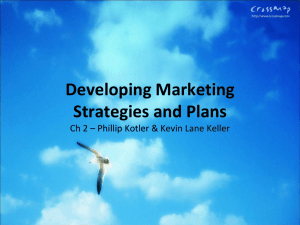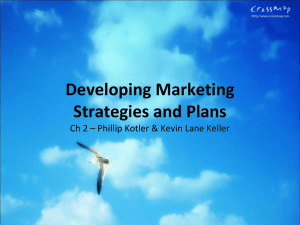Bonventure's Itinerarium Goes Secular.
advertisement
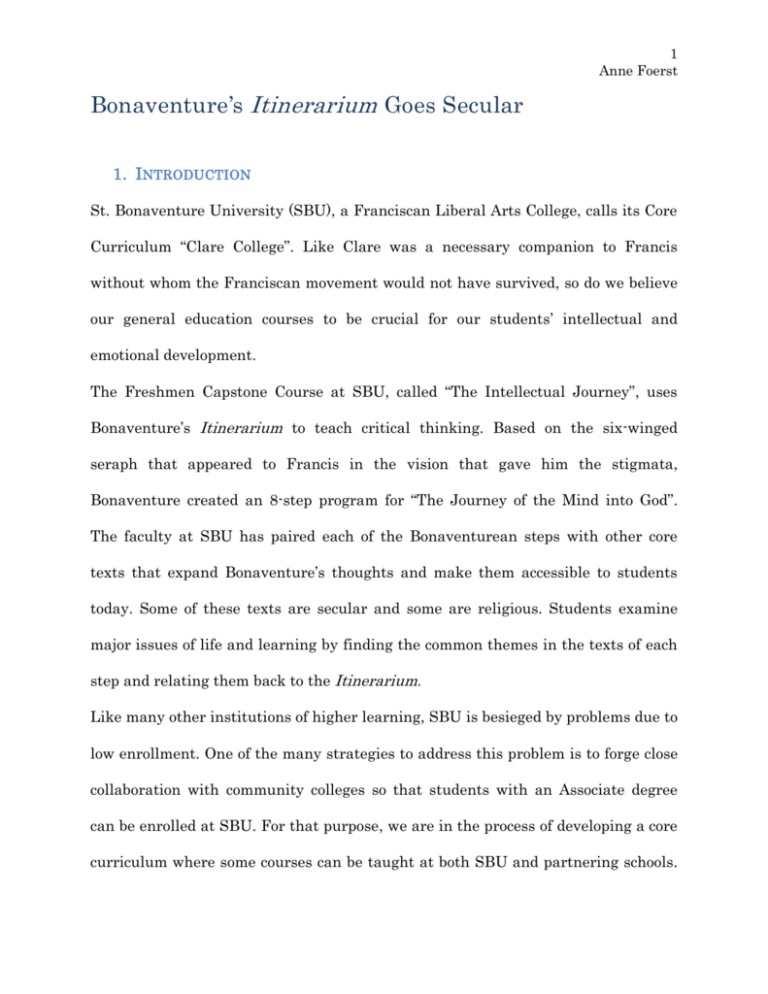
1 Anne Foerst Bonaventure’s Itinerarium Goes Secular 1. INTRODUCTION St. Bonaventure University (SBU), a Franciscan Liberal Arts College, calls its Core Curriculum “Clare College”. Like Clare was a necessary companion to Francis without whom the Franciscan movement would not have survived, so do we believe our general education courses to be crucial for our students’ intellectual and emotional development. The Freshmen Capstone Course at SBU, called “The Intellectual Journey”, uses Bonaventure’s Itinerarium to teach critical thinking. Based on the six-winged seraph that appeared to Francis in the vision that gave him the stigmata, Bonaventure created an 8-step program for “The Journey of the Mind into God”. The faculty at SBU has paired each of the Bonaventurean steps with other core texts that expand Bonaventure’s thoughts and make them accessible to students today. Some of these texts are secular and some are religious. Students examine major issues of life and learning by finding the common themes in the texts of each step and relating them back to the Itinerarium. Like many other institutions of higher learning, SBU is besieged by problems due to low enrollment. One of the many strategies to address this problem is to forge close collaboration with community colleges so that students with an Associate degree can be enrolled at SBU. For that purpose, we are in the process of developing a core curriculum where some courses can be taught at both SBU and partnering schools. 2 Anne Foerst “The Intellectual Journey” ideally would be part of such a shared core but its rootedness in the Franciscan tradition makes it unsuitable for secular institutions. The questions that arise are obvious: is it possible for a course so deeply connected to Bonaventure’s vision to be taught in a secular context? Can the depth of Bonaventure’s 8-step program of exploration be conveyed without its underlying metaphysical assumptions? Can a text that was explicitly written for Franciscan friars in 13th century Italy be made relevant for modern students living in a multicultural and globalized world? I would like to discuss a syllabus that stays true to Bonaventure’s Itinerarium without having students read the actual text. This syllabus enables students to address the Bonaventurean questions of the Outside World (step 1 & 2), the Inside World (step 3 & 4), and the Metaphysical World (step 5 & 6). It utilizes the text collection from the SBU textbook but leaves most religious texts out. It demonstrates that the 3 questions from the previous paragraph can be answered affirmatively. Since the questions Bonaventure poses are universal and timeless, it is indeed possible to teach “The Intellectual Journey” in a secular context and still remain true to Bonaventure’s ideas. 2. An Alignment of Course Goals and Objectives The course objectives of “The Intellectual Journey” are: a) Students will examine major issues in the context of the spiritual vision of Bonaventure. b) Students will analyze readings in light of the Bonaventurean themes as developed in “The Mind’s Journey into God.” 3 Anne Foerst c) Students will enhance writing ability and speaking skills and foster a close student-professor relationship in a seminar environment. The course goals are: 1. To promote an understanding of the major achievements and the modes of inquiry which have contributed to the intellectual and aesthetic development of Western culture. 2. To pursue answers to ultimate questions regarding the nature of God, persons, and the world with particular reference to the Catholic and Franciscan traditions. 3. To advance and encourage intelligent, principled and personal participation in the moral conversation and the practical dilemmas of a globalized society. 4. To promote and encourage an appreciation of other cultures and traditions as authentic expressions of what it means to be human. 5. To identify and address the past, present and future challenges confronting humanity. Since these goals and objectives rely heavily on the Franciscan tradition, they need to be changed in order to work in a secular environment. The new objectives are: a) Students will examine major issues of life and learning in 8 steps the context of the spiritual vision of Bonaventure. b) Students will analyze readings and connect them to the themes of each step in light of the Bonaventurean themes as developed in “The Mind’s Journey into God.” c) Students will enhance writing ability and speaking skills and foster a close student-professor relationship in a seminar environment. 4 Anne Foerst The new course goals are: 1. To promote an understanding of the major achievements and the modes of inquiry which have contributed to the intellectual and aesthetic development of Western culture. 2. To pursue answers to ultimate questions regarding the nature of God meaning of life, the nature of persons, and the world with particular reference to the Catholic and Franciscan traditions. 3. To advance and encourage intelligent, principled and personal participation in the moral conversation and the practical dilemmas of a globalized society. 4. To promote and encourage an appreciation of other different cultures and traditions as authentic expressions of what it means to be human. 5. To identify and address the past, present and future challenges confronting humanity. The changes in the objectives are straightforward. The explicit references to Bonaventure’s Itinerarium have been replaced with references to its underlying structure of eight steps. The vast majority of students will have encountered the concept of 8-step programs in other contexts and will not realize that this structure was introduced by a medieval theologian. The change in the goals is more subtle. Replacing the reference to God in goal 2 with “meaning” is justified by an anthropological understanding of religion as a collection of meaning giving narratives, rituals that reinforce these narratives and symbols that tie both rituals and narratives together to help foster a community. Such understanding of religion allows students to explore the question of the meaning of their own life and use the discussed texts to construct their own meaning giving narratives. This is why in goal 4 the word “other” has been replaced by 5 Anne Foerst “different”. Since in this new context the Franciscan tradition is not dominant anymore, all constructs of meaning giving narratives in the course stand equally side by side. 3. The Itinerarium When St. Bonaventure wrote his “Itinerarium”, he was at a special place in his life’s journey. He had left the university and his job as professor behind and was traveling in Northern France as a minister. After a life of intellectualism, this change affected him profoundly. Instead of focusing on intellectual pursuits, he started to concentrate on his experiences and feelings, and his sensual experiences from the road fill the whole Itinerarium. This text is not the result of ruminations behind monastery walls or of intellectual reflections at a University but of real, lived experiences. He wants to share this experience with his fellow Franciscans and reconstructs his life and his identity to encourage them to do the same. After all, humans are always on the move and ought to enjoy it. And for over 700 years, readers have drawn spiritual and emotional support from this text. Students who start college are also at a unique place in their lives: for the first time away from home, at the beginning of a journey that will lead them to a life as responsible citizens of this world. They can draw support from Bonaventure’s experience if not spiritually so at least emotionally, because Bonaventure’s ideas, though expressed through Christian metaphors, are psychologically astute and apply to people from many different backgrounds. 6 Anne Foerst His Itinerarium is not a “mapquest” that lays out the exact way every student has to travel his or her life. Quite to the contrary, he encourages each and every reader to find their own path in life. He just provides the tools. The central metaphor for his reflections is the six-winged seraph. Imagine an angel with 3 wing pairs; the prologue is the pedestal on which the angel stands, the 6 wings represent the 6 steps and the head the epilogue. We have, however, re-named the last step “step 7” to indicate that the journey doesn’t end. The wings are arranged in 3 pairs: outside world, inside world and metaphysical world – each one consisting of two steps. We have paired Bonaventure’s reflections in his 8 steps with other readings that help students to understand Bonaventure’s vision and to expand on his ideas. In the secular version, all texts from Bonaventure have been eliminated but it turns out that the other texts, sometimes accompanied by new additions, convey his thoughts and ideas to the students without them actually reading the text. 4. The Texts Textbook at SBU: The Prologue Bonaventure: “The Journey of the Mind into God” Marcus Tullius Cicero: “In Defense of the Poet Aulus Licinius Archias” Annie Dillard: “An American Childhood” (excerpt) John Henry Cardinal Newman: “The Idea of a University” (excerpt) Richard Rodriguez: “Hunger of Memory”, from “The Hunger of memory: The Education of Richard Rodriguez” Thomas Wolfe: “Young Faustus”, from “Of Time and the River: A Legend of a Man’s Hunger in his Youth” Richard Wright: “The Library Card”, from “Black Boy: A Record of Childhood and Youth” Secular Course: The Prologue 7 Anne Foerst In the Prologue, Bonaventure wants his readers to reflect on enlightenment and achieving “the peace that surpasses all understanding”. This peace comes with the insight that life is a journey and not a trip where only the arrival matters. Students learn to apply this concept of life as a journey to the college experience in general, and to their specific classes. We attempt to teach them that in all their endeavors the focus should be on the moment and not on the future goal. One key text is Newman who reflects on education as an end in itself and not as a means towards a job. For students today who are rooted in a utilitarian mindset, this is not easy to grasp and only becomes clear when they encounter examples for successful journeys in Wright, Rodriguez, and Dillard, and can contrast that with the negative example of “Young Faustus”. They learn through all these texts and Cicero that gaining knowledge can be painful but is also the end of an unexamined life. Since these texts represent and expand on Bonaventure’s ideas perfectly, there is no need to add another text. Textbook at SBU: Step 1 Secular Course: Step 1 Bonaventure: “On the Steps of the Ascent into God and on seeing God through His Vestiges in the World” Bonaventure: Excerpts from “Life of Francis [Legenda Maior]” Paul Colinvaux: “The Succession Affair”, from “Why Big Fierce Animals Are Rare” Paul Davies: “Did God Create the Universe?”, from “God and the New Physics” Genesis 1-3 Apache Myths of Creation Chippewa - Ojibwe Myths of Creation June Goodfield: “A Diversion and a Failure”, from “An Imagined World: A Story of Scientific Discovery” Aldo Leopold: “Reading the Forest Landscape” from “Sand County Almanac: And Sketches Here and There” Aldo Leopold: “Thinking Like a Mountain” 8 Anne Foerst In step 1, Bonaventure wants his readers to reflect on God, the highest, creative artist and God’s creation: the outside world, and to learn to appreciate creation and derive joy from it as it reflects God. This becomes especially clear in the excerpt of the Legenda Minor where he describes Francis’ love for God and God’s creation in erotic terms that can make students sometimes uncomfortable. Since Bonaventure uses metaphors from the 2 Biblical creation myths, we have included those into the text collection. Native American Myths are added to take away the focus on Judaism and Christianity and to demonstrate to students that many aspects are shared by these 4 ancient creation myths (the beginning in darkness, creation through words, thoughts, and deeds, serpents, floods, human’s wrongdoing etc.). Creation myths are an integral part of most religious, meaninggiving narratives because they provide us with a beginning and place us humans into a cosmological context. The narrative of evolution, on the other hand, understands human animals as egg and sperm producing meat machines whose sole purpose is to reproduce. Through the Davies text, students will learn that it is possible to integrate both accounts into their life. And they learn from the science texts that scientific observation is not objective and that scientists share Bonaventure’s awe for the complexities of nature, even though their appreciation cannot be expressed in religious terms within a scientific publication. Since Leopold’s excerpt from the “Sand County Almanac” contains numerous biblical references, it has been replaced by another, powerful Leopold essay. 9 Anne Foerst Textbook at SBU: Step 2 Secular Course: Step 2 Bonaventure: “On Seeing God through His Vestiges in this Sensible World” Matthew Arnold: “In Harmony with Nature” Francis: “Canticle of Brother Sun” Gerald Manley Hopkins: “God’s Grandeur” Robert Frost: “After Apple Picking” Barbara Novak: “The Nationalist Garden and the Holy Book”, from “Nature and Culture: American Landscape and Painting” Oliver Sacks: “The Disembodied Lady”, from “An Anthropologist from Mars: Seven Paradoxical Tales” Henry David Thoreau: “Up the West Branch”, from “The Maine Woods” William Wordsworth: “Tintern Abbey” In the second step, the second wing in our first wing pair, Bonaventure continues with his reflections on nature. But while step 1 deals with the combination of observation and awe, step 2 concentrates on our very immediate reaction to our surroundings through our senses. Bonaventure calls our senses “portals into our souls”. Since most students are familiar with the 5 senses that Bonaventure mentions (sight, hearing, smelling, tasting, touch), a reading from Sacks is included that reflects on our 6th sense of proprioception and adds some scientific dimension to the reflections, thus providing a bridge between step 1 and step 2. Humans are unique in that they judge their sensual impressions and go out of their way to create positive ones. Therefore, we have included several poems and artistic descriptions of nature. They teach us to reflect on our relationship to nature and guide us to self-reflection and the question if we are sensual, rational, or both. Wordsworth exemplifies this in literary form while Francis’ poem provides us with a religious view of the community of all creation. Arnold places humans opposite to 10 Anne Foerst and above nature. Hopkins is replaced with Frost who embraces both the beauty of nature and the work we need to put into it. Novak and, through her, a critical reflection of Thoreau, warn us of the danger of unreflected sensualism which can be abused for propaganda and can, thus, be a means for manipulation. Textbook at SBU: Step 3 Secular Course: Step 3 Bonaventure: “On Seeing God through His Image Imprinted in Our Natural Powers” Augustine: “Confessions” (excerpts from book I, VII, and VIII) Marcus Aurelius Antoninus: “Meditations” (excerpts from 1, 2, 3, 4, 11) Maxine Hong Kingston: “A Song for a Barbarian Reed Pipe”, from “The Woman Warrior: Memoirs of a Childhood among Ghosts” Michel de Montaigne: “Why I Paint My Own Portrait?”, from “The Autobiography of Michel de Montaigne, Comprising the Life of the Wisest Man of His Time” Jean-Paul Sartre: “Existentialism is a Humanism” In step 3, Bonaventure wants us to apply the insights from the previous steps to ourselves. So, the third and fourth step represent the second wing pair of our sixwinged seraph and reflect the inside world, our innermost thoughts and feelings. And step 3 focuses on the question “Who am I?” The first creation story teaches us that we are “images of God”, statues of God and thus all valuable and unique. But is this an easy concept to grasp? And is it easy to know ourselves? And if we really are honest and knowledgeable about ourselves, is it then easy to accept ourselves? Bonaventure would have found our modern concept of individualism quite strange, as would have Augustine and Marcus Aurelius. Yet, both present valid selfreflections students can empathize with, thus realizing that the human experience 11 Anne Foerst transcends time and space. We have nonetheless thought it appropriate to accompany these Classical texts by modern one’s as well, whose sense of self is closer to the one we intuit today, and who guide students to the question if and how they can be content with who they are. Textbook at SBU: Step 4 Secular Course: Step 4 Bonaventure: “On Seeing God in His Image Reformed” Simone de Beauvoir “The Second Sex” (excerpt) George Gordon, Lord Byron: “Childe Harold’s Pilgrimage” Freud: “Civilization and Its Discontents” (excerpt) Martin Luther King Jr.: “Letter from Birmingham Jail” Marx and Engels: “The Communist Manifesto” (chapter 3) Vatican Council II: “Gaudium es Spes” (Pastoral Constitution on the Church in the Modern World) In the SBU version of the course, we deviate from Bonaventure in step 4. He focuses on the estranged nature of human beings and we add the social dimension which is of particular importance in our modern, secular world. Bonaventure’s concept of “original sin” is now replaced by social estrangement. Students continue their journey into the “inside world” by reflecting their role in society, how they are influenced by their culture and how they themselves can impact it. They reflect on justice and oppression and how they can help to create a just society. Textbook at SBU: Step 5 Bonaventure” “About Meditating on God’s Unity by using God’s Primary Name, which is ‘Being’” The Chandogya Upanishad (excerpts) John Donne: “Sermon XXIII” John Donne: “Sonnet 10: Death, Be Not Proud” John Donne: Sonnet 14: Batter My Heart, Three Person’d God” Elisabeth Johnson: “Speaking about the Living God: She Who Is”, from “She Who Is: The Mystery of God in Feminist Theological Discourse” Secular Course: Step 5 12 Anne Foerst Ursula LeGuin: “Schrödinger’s Cat”, from “The Compass Rose” Plato: “The Allegory of the Cave” Huston Smith: “The Beyond Within”, from “The World’s Religions” The last wing pair of Bonaventure’s seraph represents the metaphysical world. The term “metaphysics” literally means “beyond the physical world.” Here, we address questions that go beyond our immediate social and sensual concerns. Students will learn about Hinduism (Chandogya, Smith) and will encounter surprising similarities between Hindu and Christian practice. They will read one of the most famous texts about the feebleness of our concept of reality: Plato’s “Allegory of the Cave”. They will learn that all talk about metaphysics is metaphorical, and will learn about the language games that necessarily occur when speaking about the unspeakable (LeGuin, Johnson) and how challenging this insecurity can be (Donne). Ultimately, they will learn to question the concepts of truth and reality. Textbook at SBU: Step 6 Secular Course: Step 6 Bonaventure: “About Meditatingt on God’s Most Blessed Trinity by using God’s Name ‘The Good’” Aristotle: “Nicomachean Ethics (selections from Book 1 and2) Don DeLillo: “Waves and Radiation”, from “White Noise” Emily Dickinson: “Apparently With No Surprise” Emily Dickinson: “I Heard a Fly Buzz When I Died” Emily Dickinson: “Because I Could Not Stop for Death” Homer: “The Iliad” (Book 24) Matthew 5-7: “The Sermon of the Mount” The last step on metaphysics finally enables us to ask how we ought to live. As human beings we are confronted with the certainty of death and meaninglessness. This reality leads us to the quest for meaning and the reflection of the values that guide our actions and behaviors. Through Homer, Aristotle and The Sermon of the 13 Anne Foerst Mount, students will learn to reflect on the questions of What is the good? What does it mean to live a good life? How should I act? Is our life meaningful? What are my values? Through Dickinson and a re-reflection of Donne’s poem in Step 5 they will reflect on the role of death for the construction of meaning and values. Textbook at SBU: Step 7 Secular Course: Step 7 Bonaventure: “About the Mystical Transport of the Mind, in Which Rest is Given to the Intellect after our Affection Passes over Totally into God through Ecstasy” Dante Alighieri: “The Divine Comedy” (excerpts) Euripides: “Bacchae” Herman Hesse: “Steps” (Stufen) John Keats: “On First Looking into Chapman’s Homer” Thomas Merton: “The Sleeping Volcano”, from “The Seven Storey Mountain” Francesco Petrarca: “Ascent of Mount Ventoux. A Letter to Dionisio da Borga San Sepolcro” Step 7 is not an epilogue. It is not the bookend that complements the prologue. Rather, it reminds us that life’s journey never ends. While the semester and this course will end for the students for now, we hope that the questions that have been addressed will accompany them throughout the rest of their college career and likely throughout the rest of their life. They will read texts that help them to revisit the previous steps (Keats, Hesse, Petrarca) and see them in a new life now that their first journey through all steps is completed. They will also reflect on the necessity for joy and relaxation (Euripides, Dante) because we need the element of fun in our life. 14 Anne Foerst 5. Conclusion This text selection allows us to address Bonaventure’s questions in a secular context. This demonstrates not only the universality of his questions but also that those deep questions of meaning and how to live a good life are important in any context of higher education. It finally allows us to introduce the concept of a liberal arts education to community college students. Through this course they will experience the joy of learning for learning’s sake, and the insight that the human experience and the quest for meaning transcends time, space and worldview.
